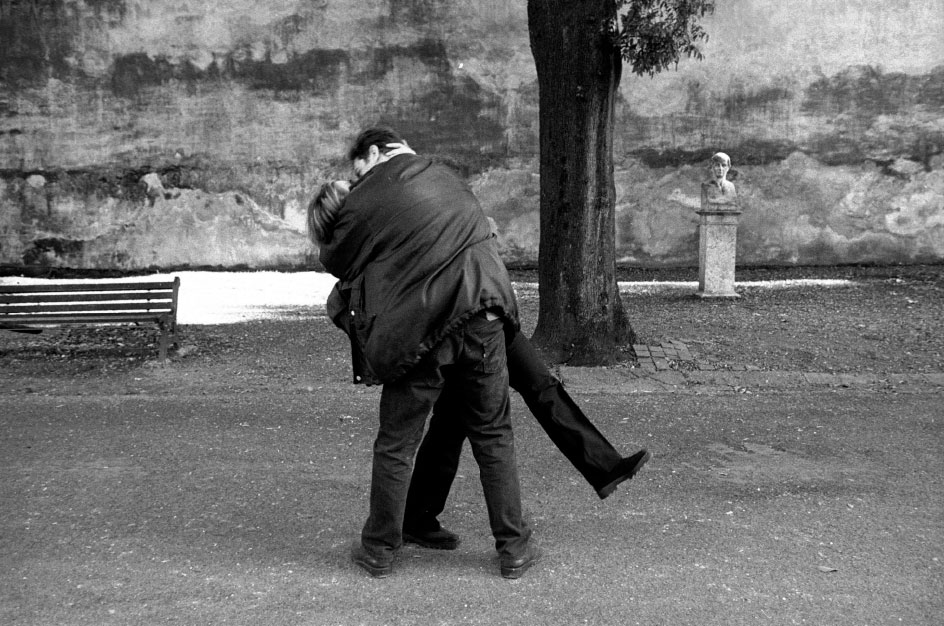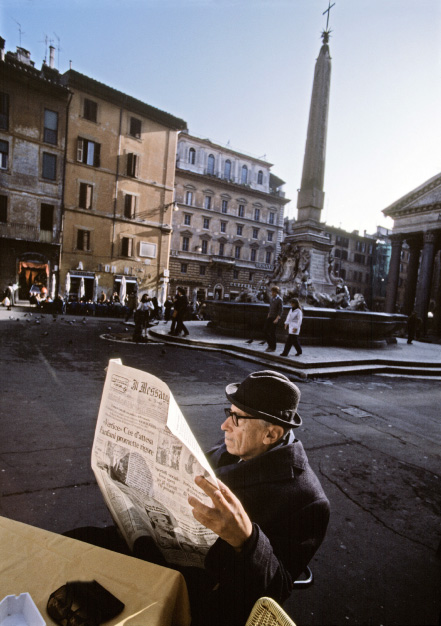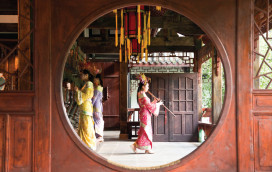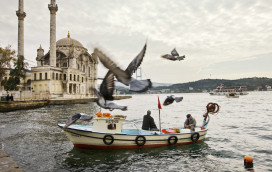When Mary Shelley sat down to write her letters home in the early spring of 1819, she had already fallen in love. The author of Frankenstein and the wife of the famous poet had arrived in Rome a few days before, and the city had seduced her. Basking in the warm Roman sun, contemplating countless masterpieces across two and a half millennia of history, she was enthralled. “The delights of Rome have had such an effect on me that my past life appears a blank,” she wrote breathlessly, “and now I begin to live.”
Mary knew well the Piazza del Popolo, the square in which I am sitting at the Caffè Canova, enjoying a croissant and the best coffee in the world. A wide oval, the piazza is framed by curving balustraded roadways and centred on fountains spewing curtains of silver water. To the south, twin churches mark the entrance to the city. On the opposite corner, by the Dal Bolognese restaurant, where film stars dine on Saturday evenings and cardinals have Sunday lunch, two carabinieri pose in uniforms that are more Gilbert & Sullivan than constables on the beat. Two nuns glide by, twins in wimpled black, passing a young couple locked in an embrace on the rim of the central fountain. The shadow of the obelisk that Augustus brought back from Egypt after defeating two of the great lovers of antiquity – Antony and Cleopatra – stretches across the cobblestones to touch my feet.
Cavalcades of ghosts roam this piazza. Before trains and airplanes gave us more mundane backdrops, the square was the grand stage for Roman arrivals. For more than 17 centuries, all those who made the journey to Rome from elsewhere in Europe – kings and popes, armies and emissaries, merchants and pilgrims – entered the city through the great Porta del Popolo opposite. Martin Luther lodged here while formulating ideas that would lead to the great schism of the Protestant Reformation. Queen Christina of Sweden – libertine, libertarian and lesbian – rode through Porta del Popolo opposite, waving to welcoming crowds, believing she was escaping the constraints of a northern throne for the freedoms of southern indulgence. Bonnie Prince Charlie – pretender to the thrones of England, Scotland and Ireland, and born in this city – paused here to splash his face in the fountains after another drunken night.
But the journeys and the arrivals that fascinate me are those of the early tourists, the travelers on what came to be known as the Grand Tour, a phenomenon of the 18th and 19th centuries in which gentlemen and sometimes ladies of means toured the continent to add some polish and sophistication to their manners and education. With its wealth of artistic treasure, Italy was always the highlight of these European journeys, and Rome, the ‘Great Crown of the Grand Tour’, the ultimate destination.
Among them were famous writers and artists. John Keats, Percy Bysshe Shelley and Lord Byron all hurried across the cobbles of Piazza del Popolo. Stendhal, Algernon Charles Swinburne, William Wordsworth, Sir Walter Scott, Nathaniel Hawthorne, Charles Dickens – all went “reeling and moaning about the Roman streets”. Henry James echoed Mary Shelley’s passion for the city. “For the first time,” he wrote to his brother on the evening of his arrival, “I live.”
The journey to Italy and to Rome started with the Alps, “those uncouth, huge, monstrous excrescences of nature”, according to one 18th-century traveler. Some visitors, like Horace Walpole, whose King Charles spaniel was carried off and promptly eaten by a wolf, rode mules along the snowy precipices. Others, like James Boswell, were carried in palanquins by sure-footed porters. Boswell was said to have crossed the Alps “with mingled feelings of awe and adulterous anticipation”. Italian women were one of the attractions of any journey through Italy.
Boswell was probably anticipating Venice, whose courtesans were famous. The Frenchman Charles de Brosses described them as a cross between fairies and angels; heroically, he tried eight in order to get a decent sampling. But nuns were generally considered to be the most passionate lovers in Venice; there was a famous incident of a nun fighting a duel with an abbess over a mutual lover. Someone should have told Boswell. His adulterous intentions towards a promising Venetian woman “of some social standing” met with a sad rebuff.
From Venice our travelers crossed the Apennines to Florence. The journey could be difficult (in one wayside inn William Beckford was offered a dinner of mustard and crow’s gizzards) but everyone loved the city on the Arno. As always, there seemed to be too much to see: one 18th-century guidebook listed 160 public statues, 152 churches, 18 guildhalls, 17 palaces, six columns and two pyramids, without even mentioning the countless paintings. Tired of the sights, Sir Horace Mann was fortunate to catch the Carnival with its masked balls and its bacchanalian amusements. “I have danced,” he cried. “Good Gods! How have I danced!”
As the travelers turned south to Rome they followed the Via Cassia of the Roman legionnaires and the Via Francigena, the centuries-old pilgrim route to Rome. Both led directly to the Porta del Popolo, where, stretching their legs, they marveled at the theatrical entrance to the city. But the piazza was hardly journey’s end. Rome, which Lord Byron called “the city of the soul”, awaited them.
I finish the last of my croissant and coffee and set off to follow the travelers on their ramblings around the city they knew as Caput Mundi, the Capital of the World. A short walk round the corner into the Via del Corso, once the scene of riderless horse races, brings me to the rooms where Goethe lodged. The great German writer came to Rome in search of classical art. But in the humble rooms in Via del Corso, where he once lay writing verses on his lover’s naked back, he found love, passion and erotic emancipation. By his own account, Rome and his love affair with his Italian mistress changed his life. “Eros has arrows of various kinds,” he wrote. “Some seem just to scratch us… others, strong-feathered and freshly pointed and sharpened – right to the marrow they pierce.” His love nest is now a small museum, the Casa di Goethe, and its exhibitions trace the transformations of the man known as the German Shakespeare. Pick up a copy of his Roman Elegies; erotic poetry was never so exquisite.
From Goethe’s apartment I cross to Via del Babuino and the entrance to Via Margutta, one of the most charming streets in Rome. Long associated with visiting writers and artists, it was home to people like Sir Thomas Lawrence, the president of the Royal Academy of Arts, who lived here in the early 19th century. It is the street itself, as well as its associations, that is so seductive. Rising rents have forced most artists to look elsewhere for studios, but this pedestrian backwater, with its small galleries and antique shops, retains the atmosphere of an earlier Rome. The tiny Osteria Margutta at number 82 is my favorite place for romantic candlelit dinners. Bring along a copy of Goethe’s Elegies to read over the dolci.
Back in Via del Babuino I’m on the trail of Keats, the tragic young poet who arrived in Rome in 1820. At the end of the street I emerge in the Piazza di Spagna, where the Spanish Steps, strewn with flowers, rise to the double spires of the church of Trinità dei Monti. In the 18th and 19th centuries the area was known as the English Ghetto. As early as 1740, Horace Walpole was complaining that the English in Rome seemed numberless; the Italians had taken to calling them milordi.
Just to the left of the Spanish Steps is one of their favorite haunts, Babington’s Tea Rooms, still serving English afternoon teas between the beveled mirrors and the palms. Not far away, in fashionable Via Condotti, is another of their haunts, the Caffè Greco. After two and a half centuries, the fittings and the paintings still evoke the long-lost world of the Grand Tour.
Hard by the Spanish Steps is the Keats-Shelley House, now a museum to the two Romantic poets. Already suffering from tuberculosis, a lovelorn Keats came to Rome in the hope that a sunnier climate might provide a cure. With its book-lined rooms, the house is a wonderfully atmospheric place. I climb the stairs to the narrow chamber where Keats lay day and night gazing at the ceiling that his friend, the painter Joseph Severn, had decorated with flowers for him. He died here, on a dark winter day in February 1821, barely 25 years old, still dreaming of his beloved Fanny Brawne, left behind in London. It remains one of the most moving places in Rome.
Back outside I climb the Spanish Steps to the district of the visiting French. Architects routinely praise the way the steps are visible from all angles. But the builder, Francesco de Sanctis, did not have aesthetic considerations in mind. “I will make the steps visible from everywhere,” he sniffed, “because the reverend fathers [of the French church atop the hill] have alerted me to the gross indecencies committed on that shrubbery slope by couples who often hide there.”
The French always have an eye for the best real estate, and the area at the top of the steps enjoys some of the finest views in Rome. I follow the Viale Trinità dei Monti to a wonderful Renaissance creation, the Villa Medici, “acquired” by Napoleon for the French Academy. Visiting artists are still granted studio space here, but for the general traveler there are tours of the apartments and the gardens that feel like a secret retreat. A little farther along the Pincio Hill is the Casina Valadier, named after the man who designed the Piazza del Popolo. Its elegant terraces are the ideal place for lunch with a view over Roman rooftops where domes rise like hot-air balloons.
Away to the left, you can see the white “wedding cake” creation of the Monument to Victor Emmanuel II, commonly called the Vittoriano, and just behind it, the Forum of ancient Rome. In the days when Latin and Greek were still part of a normal school curriculum, most travelers on the Grand Tour had read Cicero and Virgil, Ovid and Horace, and were thrilled to be wandering the streets where they had lived and died. Many enlisted the services of guides to show them around ancient sights. The great German guide Johann Joachim Winckelmann, who became the leading 18th-century authority on classical art, was much sought after. He was a man of considerable tact. Showing John Wilkes around the Forum, Winckelmann kindly pretended not to notice when he and his mistress, overcome by lust, disappeared for some moments behind a ruin. All the more obliging, Wilkes commented later, because he had to pass the interval with his mistress’s mother, “who had as little conversation as beauty”.
But no visitor is more closely identified with ancient Rome than Edward Gibbon. I climb the long steps to Michelangelo’s glorious Piazza del Campidoglio, centred on the equestrian statue of Marcus Aurelius. Just beyond the piazza in the far left corner is a balcony overlooking the ruins of the Forum. Gibbon came here one fateful evening in the autumn of 1764 in reflective mood. The sound of the friars chanting litanies in the Church of Santa Maria d’Aracoeli wafted across the piazza. As he looked down on the Forum “where Romulus stood, or Tully spoke, or Caesar fell”, he conceived the idea of writing The Decline and Fall of the Roman Empire, one of the seminal works of European history.
Keats’ great friend Shelley also found inspiration in Rome’s sprawling ruins. Shelley adored Italy and spent several years here, where his curious domestic arrangements – in addition to his wife Mary he seemed to travel at different times with two mistresses – didn’t seem to raise any eyebrows. The spring of 1819 found him lodged with Mary, Claire the “nanny”, and his son William in the Palazzo Verospi in the Via del Corso, not far from where Goethe had lived some decades earlier.
The Shelleys spent their mornings exploring the ruins and the art collections and their afternoons riding through the gardens of the Quirinale and the Villa Borghese, the latter still Rome’s great green oasis. In the churches, Mary wrote, “we see the divinest of statues and… hear the music of angels”. Shelley loved to wander the city alone by moonlight, when the evening breezes brought sweet aromas from the country. His favorite destination was the vast Baths of Caracalla, the most spectacular of Rome’s ruins. It was here, beneath the arches, that he wrote Prometheus Unbound.
I hop on the No. 3 tram from Trastevere to the Protestant Cemetery, one of the stops on Shelley’s moonlight rambles, by a southern gate of the city, close to the Pyramid of Cestius. “It might make one in love with death,” he wrote, “to think that one should be buried in so sweet a place.” Pines and cypresses separate the rows of tombs. The colony of cats that has lived here for generations has its own charity box just inside the gate. You can find Keats’ grave in the far left corner, shaded by trees, inscribed with a single line: “Here lies one whose name was writ in water.”
In July 1822 Shelley drowned after his boat capsized in a storm off the coast at Livorno. Mary accompanied his ashes across the Piazza del Popolo and through the city to burial in the cemetery. His gravestone is inscribed with Ariel’s lines from The Tempest: “Nothing of him that doth fade/But doth suffer a sea change/Into something rich and strange.”
It reads like an epithet for the city itself, the Eternal City, still rich and strange, still unfaded after the many sea changes of two millennia. For generations of visitors, Rome has been a revelation. No city in the world has been the destination of so many journeys, or has transformed the lives of so many travelers.
Your address: The St. Regis Rome





